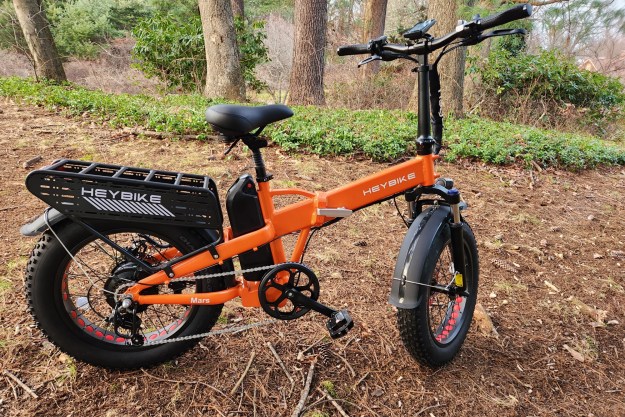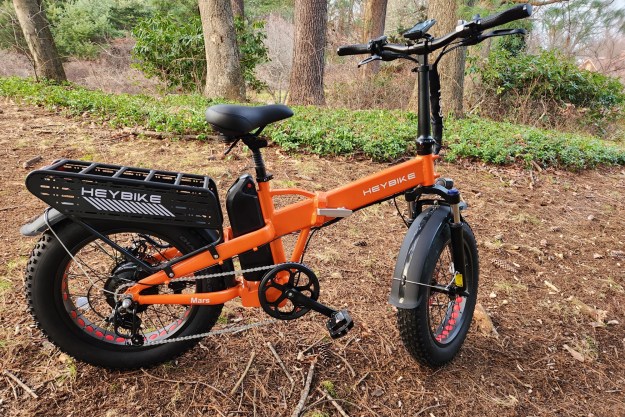
“The Heybike Mars 2.0 gets up to speed quickly, and folds down in size easily.”
- Especially attractive appearance
- Useful design features such as a foldup seat
- Easily accessible power to 28 mph
- Versatile rear rack
- Folds easily
- Seat post suspension helps ride comfort
- Mechanical brakes are marginal
- Relatively low-power battery
- Mirrors are not standard
- Expensive list price
If you’re shopping for your first e-bike and not sure what type or brand to buy, there are several good reasons to start with a folding electric bike. This winter, I found a lot to like when I tested the spiffy-looking Heybike Mars 2.0. In general, e-bike prices have dropped 20% to 30% in the past year, with some of the most significant discounts in the highly competitive folding e-bike category.
The well-built Heybike Mars 2.0 is a fat tire folding e-bike that arrives fully assembled in a cubelike carton. Just unfold it, inflate the tires, charge the battery, and get going. Its 1,200-watt peak power rear hub motor can help it reach its 28 mph top speed faster than many other models, and it comes with a lot of convenient features. The Mars 2.0 isn’t perfect, but overall, it’s very good. Perhaps the biggest issue in choosing a Mars 2.0 may be its price at the time of purchase.
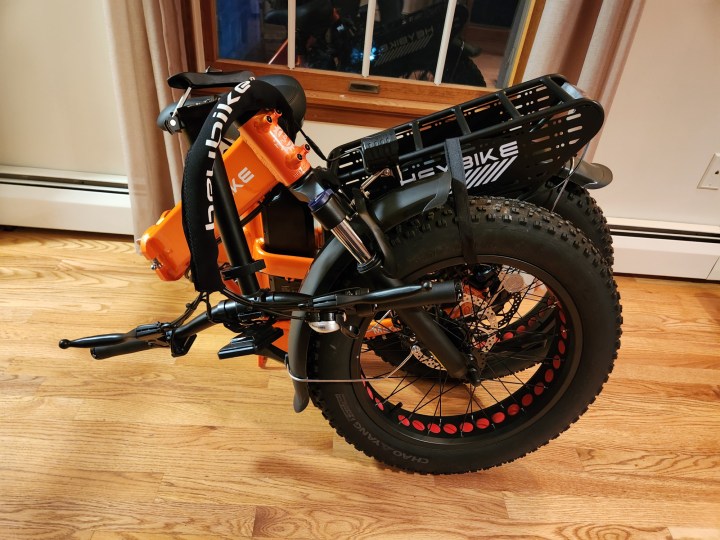
The virtues of a folding e-bike
Heybike recommends the Mars 2.0 for riders from 5-feet, 3-inches to 6-feet, 1-inch tall. The seat height adjusts from 29 inches to 34.3 inches, and the total carrying capacity is 330 pounds, including rider, passenger, and cargo. It weighs 75 pounds, which is about average for folding models in this price range. The GoCycle G4 folding e-bike weighs just 38 pounds, but it also costs $3,500.
With the Mars 2.0 configured in Class 3 mode, it scooted up to 28 mph.
Most people wouldn’t want to carry the Mars 2.0 up and down multiple flights of stairs at home or work daily, but transporting it by car or SUV is much easier when you can fold it and tuck it in the back. The other primary advantage is that folded bikes don’t require much floor space, and you can store one in a closet or beside a desk.
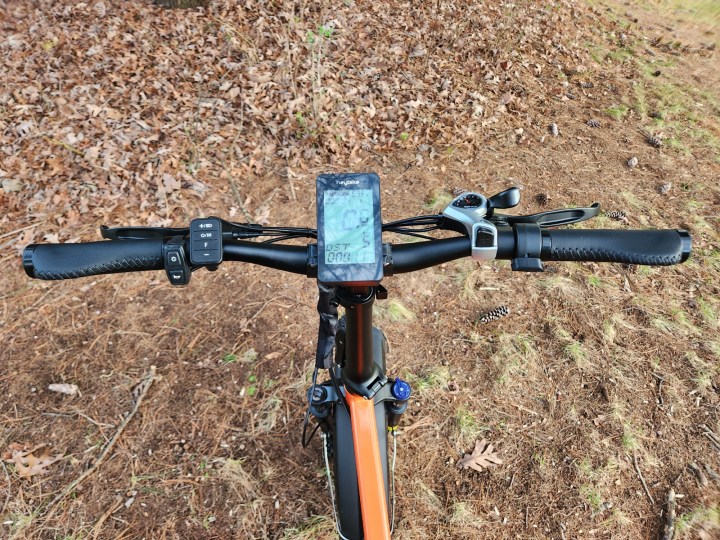
Power to spare
I was pleasantly surprised by the Mars 2.0’s power train. The e-bike’s 48-volt brushless, geared rear hub motor produces 750 watts of continuous power, with 1,200 watts of peak power. Most 750-watt motors peak at 1,000 watts. The motor also puts out 80 Newton meters of torque, roughly 59 ft-lb, which is more than average. With the Mars 2.0 configured in Class 3 mode, it scooted up to 28 mph.
The 48V lithium-ion battery for the Mars 2.0 fits on a bracket attached to the back of the downtube under the seat. The battery has a modest 12.5 ampere hours of power that Heybike claims gives it a maximum 45-mile range per charge. That range seems optimistic, given the bike’s weight and peppy motor. If you stick to the first or second powered pedal assist modes, keep the speed under 15 mph, and pedal using the Shimano 7-speed gear set most of the time, you might get close to the 45-mile range. Cut the rating by half or more if you utilize the thumb throttle most of the time and like to feel the breeze while riding at mid-20-mph speeds.
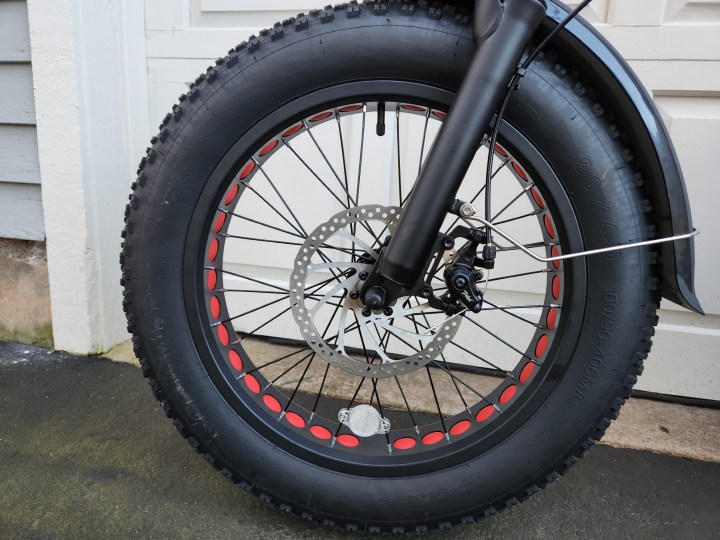
If you commute 10 or 12 miles each way, which is a typical distance, you could probably get away with battery-only propulsion if you charged the battery each night. Otherwise, you might consider carrying a spare battery, a $340 option. Heybike supplies a 2A charger with the Mars 2.0, sand charging an empty battery to 100% should take about 6.5 hours.
I have one moderate concern about the Heybike Mars 2.0’s performance: It has mechanical disc brakes. On the plus side, the Mars 2.0 has 180mm brake rotors, which is better than the 160mm rotors on the Engwe EP-2 Pro electric folding bike, which also has mechanical brakes. However, hydraulic disc brakes have firmer and smoother stopping power than mechanical brakes. The current benchmark for folding e-bikes is the Lectric XP 3.0, which has a low price point, but still includes hydraulic brakes with 180mm rotors.
The Mars 2.0’s motor peaks higher and has more torque than the Lectric XP 3.0 or the Engwe EP-2 Pro motors, and that’s great. However, balancing go power with stopping power is essential. I know that when I ride or drive anything with much power, I tend to go faster, so the brakes matter. In my testing, I had no issues stopping the Mars 2.0 firmly and quickly, but the mechanical brakes are one of the few drawbacks.
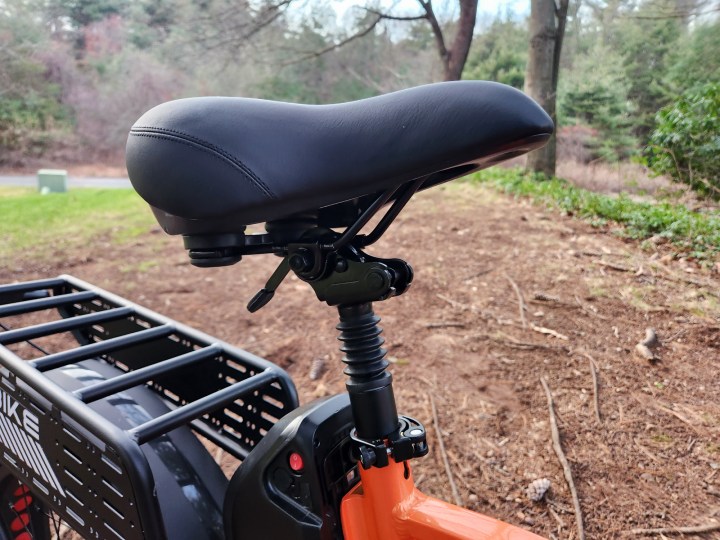
Mars 2.0 design features
You may have noticed the colorful cutouts in the inner rim of the Mars 2.0’s 20-inch wheels. The cutouts save a bit of weight, and I think they look cool, but otherwise, there’s no significant functional advantage.
The e-bike has four frame color choices: Leather Black, Granite Gray, Dusty Blue, and Pumpkin Orange. I asked Heybike to send the color it thought would look the best in photographs, so they picked Pumpkin Orange, which also decided the tire detail colors.
Lifting a lever behind the Mars 2.0’s seat gives access to the battery. You’ll notice in the photo below that the seat is pretty thick and has a pair of sturdy springs, plus it mounts on a suspension seat post that compresses a bit when you go over bumps. Though the front forks only offer a modest 65mm of travel, the Mars 2.0 delivers a relatively smooth ride thanks to the seat, suspension post, and fat tires. You won’t want to take this e-bike on aggressive trails, but it handles well without beating you up when you venture off smooth pavement.
The unique standard rear rack is another welcome feature of the Mars 2.0. It’s rated to hold up to 120 pounds, and the cutouts on the sides and top rails make it easy to tie cargo or attach accessories.
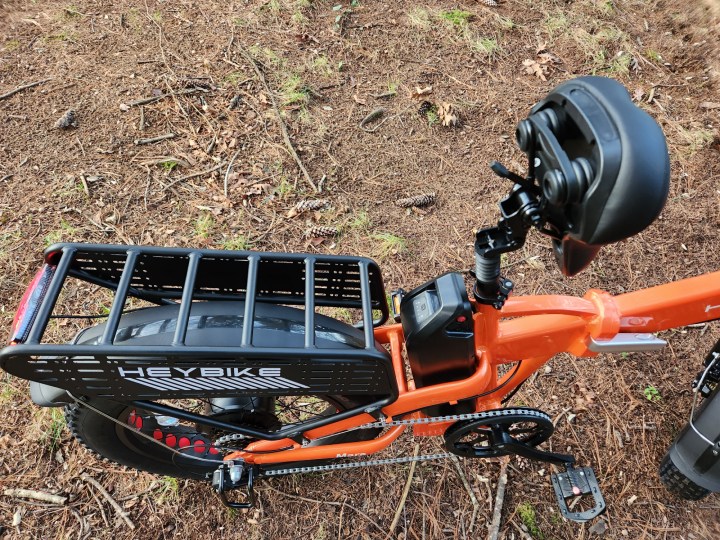
Heybike Mars 2.0 accessories
Heybike sells the Mars 2.0 well-equipped with fenders, a rear rack, a headlamp, and a rear lamp with brake light. There’s a reasonably loud horn and a USB port so you can charge devices while you ride. There’s also a mobile app that can track and analyze your rides, as well as configure e-bike settings.
I asked Heybike to send a set of mirrors, a smartphone mount, and saddlebags, all seen below, mounted on the bike. Heybike also sells accessory baskets, bags, locks, and more.
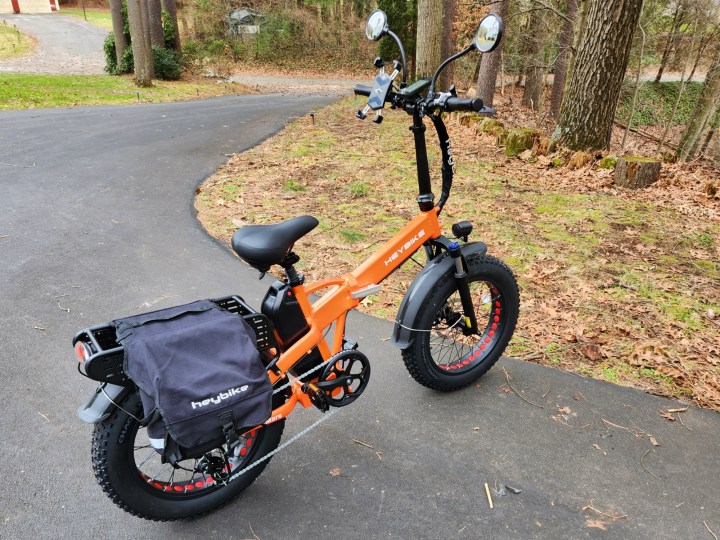
The price is (sometimes) right
The Heybike Mars 2.0 gets up to speed quickly, and the standard suspension seat post is a welcome complement to the front fork suspension. I wish it had hydraulic brakes, but the more significant issue is the price.
Heybike lists the Mars 2.0 for $1,500, but it’s frequently on sale for significantly less. That’s good, because it’s frankly hard to recommend the Mars 2.0 at $1,500 when it has such tough competition. The class leader Lectric XP 3.0 with hydraulic brakes (and with a less powerful motor) sells for $999, and the also very good Engwe EP-2 Pro currently lists for $899.
If the seemingly permanent “sale” price is the actual price, the Mars 2.0 is an excellent deal. So take a look, and if the price isn’t right, wait a bit.
Editors’ Recommendations
Services Marketplace – Listings, Bookings & Reviews
